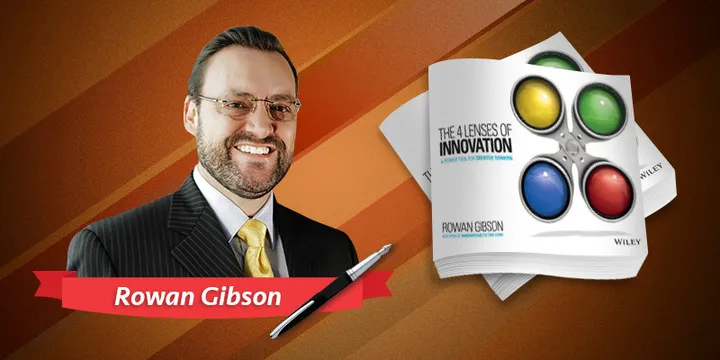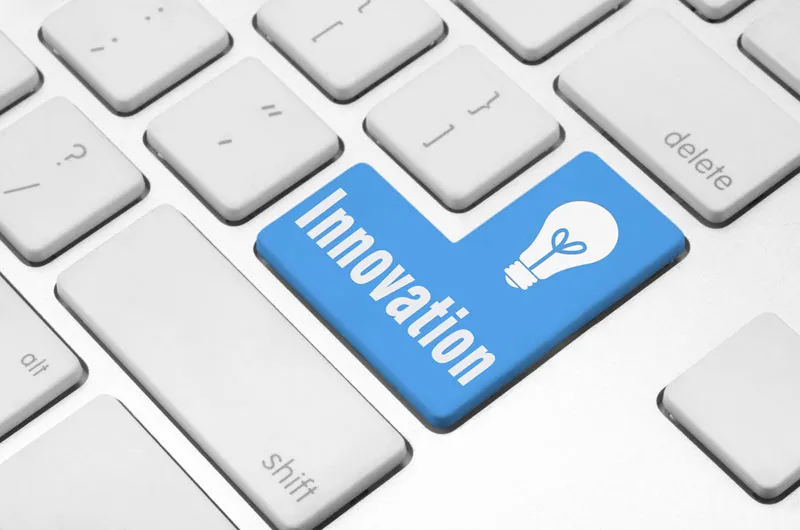‘Never accept boundaries’ – interview with Rowan Gibson, author, ‘Four Lenses of Innovation’
Rowan Gibson is the author of the bestseller The Four Lenses of Innovation: A Power Tool for Creative Thinking (see my book review). He has co-founded the site InnovationExcellence.com, and has addressed a range of companies including Accenture, Apple, Bayer, Credit Suisse, Dow Chemicals, Haier, Heineken, IBM, Microsoft, Philips, P&G, Siemens, Telefonica and Volkswagen.
Rowan joins us in this wide-ranging interview on the new waves of innovation, the power of insights, changing impacts on strategy, and the rise of innovation-centric government polices around the world.

YS: In the time since your book was published, what are some notable new examples you have come across of innovation practices or outcomes?
RG: Wow! There is just so much innovation going on across so many domains. One of my favourite innovation concepts is a medical drone that contains a defibrillator. It can get to someone who’s just suffered a heart attack much faster than an ambulance that might get stuck in traffic.
Tesla continues to amaze me. Recently they offered Model S owners the opportunity to take advantage of the driverless technology function simply by downloading a software upgrade to their cars. They also offer an app that lets you turn on the vehicle’s air-conditioning remotely so you can cool the car down before you even get it to where it’s parked.
Other companies are also doing some really cool stuff. Google is moving into ridesharing now, with a new carpooling app from Waze. Amazon has introduced a $50 tablet that is so cheap they actually sell them in six-packs. Samsung has developed rear-mounted safety screens for trucks to help overtaking-drivers see the road ahead and avoid accidents.
Wearables are also on the increase. Ralph Lauren entered this market recently with their Polo Tech Shirt for athletes, and there’s now even a smart jacket for motorcyclists that contains its own airbag.
Then there are the ‘Exponentials’ – technology innovations that are accelerating faster than Moore’s law. Artificial intelligence is one. IBM Watson is, of course, stunning in its capabilities but this is just the beginning. I predict that we are moving into an increasingly ‘artificial’ world as this technology advances and eventually augments or replaces the work of traditional professionals like doctors and lawyers. Facebook has just launched M, its new virtual assistant, which runs on AI.
Robotics is another exponential technology, and again it impacts so many fields. There’s now a robotic bricklayer, for example, that can build a house in two days. Yamaha has just introduced a humanoid robot that can ride a motorcycle.
And think about the revolution in 3D Printing. Healthcare is one industry that’s already benefiting. One patient recently received a 3D-printed rib cage, and scientists are already working a 3-D printed heart. So we’re arguably seeing more innovation today than at any other time of human history.
YS: How was your book Four Lenses of Innovation received? What were some of the unusual responses and reactions you got?
RG: Reactions to the book have been very positive. I think people were really surprised to see a business book in this kind of format and with such a high level of graphics. One reviewer described it as ‘Eye Candy for the Creative Mind’ which was wonderful.
People don’t usually describe a business book as ‘incredibly beautiful.’ but that’s the kind of instant response we get from readers when they first see it in a bookstore or receive it at home or the office. I think that makes for a more enjoyable read. I wanted to produce a book that offers a differentiated reading experience compared to consuming content online. And people tell me the book has really opened their minds in terms of understanding innovation and the creative process itself.
YS: What is your current field of research in the area of innovation?
RG: One topic I’m looking at in particular is the whole field of insights. Ten years ago we talked about the ‘Innovation Economy.’ Today, we talk about the ‘Insight Economy’ because we’ve come to understand that truly breakthrough innovation is always insight-driven. So there’s a lot of work being done today in this field, and it is increasingly being enabled by technologies such as Big Data analytics and other tools that can turn raw data into insights at remarkable speed.
In the book, I wrote a whole section on the role of insights called ‘How Big Ideas Are Built’ that shows how insights actually trigger new thinking in our minds and lead us to Eureka moments. I like to say that if ideas are ‘the front end of innovation’ then insights are ‘the front end of the front end.’ It’s a really fascinating field.
YS: How should innovators strike that delicate balance between ‘Stick to your vision’ and ‘Adapt to a changed world in the face of new data’?
RG: I believe that unless you are making a product where tradition is intrinsic to the value proposition – like, say, Jack Daniels Tennessee Whiskey, for example – and that cannot be digitised, you should be continuously asking yourself how long it will be before your products, your services, and your whole business model are rendered obsolete. Industry disruption is the new norm.
You still need a vision, of course. But the horizon has to be much closer now. We no longer have the luxury of thinking in terms of decades. These days, a business model may have a lifetime of five years, three years, two years. Think about how many industries now have a fundamentally broken or at least threatened business model: music publishing, movie distribution, cable TV, advertising, fast food, telecommunications, retail, traditional media publishing, and financial services, to name just a few.
The question we need to be constantly asking is: “Are we changing as fast as the world is changing?” Today, it’s all about how fast you can drive strategic renewal at the level of the core business model. And the fuel for renewal is innovation. Remember, Kodak stuck to their vision of photographic film versus digital photography for way too long and paid a heavy price.
YS: What are good examples you have come across of companies who completely pivoted in their strategy/operations because of new innovation insights?
RG: Interestingly, one of those companies is FujiFilm. For many years, of course, they shared Kodak’s vision that digital photography was just going to be a side-line – and not a very profitable one. But then, as the digital revolution began to take off, FujiFilm’s revenues from selling film began to fall off a cliff, just like Kodak’s.
The difference at FujiFilm was that instead of saying, “OK, world, we get the message. We’re now going to become a digital photography company” (which meant at Kodak that profits were decimated), they actually said, “OK, we get it, we’ve got to start inventing new and different sources of profit before the old sources of profit disappear.”

So now, in addition to digital cameras, FujiFilm sells interactive films for touchscreen displays, film materials for solar panels, photocopiers and printers, medical scanners, cosmetics and even pharmaceuticals. Today they are a $22 billion company where Kodak has of course gone belly up. FujiFilm’s insight was that it had some very valuable technological competencies and strategic assets that could be redeployed and stretched into all kinds of new growth opportunities. This is what I refer to in the book as the third lens of innovation.
Another of my favourite examples is Netflix. The company’s CEO, Reed Hastings, used the second lens of innovation – Harnessing Trends – to great effect. As soon as Internet video streaming technology became mature enough for it to go mainstream, he realised it represented not just the future of the video rental business but the future of TV. Based on this insight, he decided to shift his whole business model from home DVD delivery to video on demand. While Blockbuster Video has disappeared from the scene, Netflix now has more than 66 million paid subscribers globally.
YS: What are the kinds of challenges entrepreneurs face with their board of directors or investors during innovation, and how can they be overcome when the company needs to change or pivot?
RG: This can be very tough. Netflix went through a real battle with they switched their focus from DVD rental to streaming media. In essence, they hiked up the price of the DVD rental service and forced customers rather brutally to subscribe to streaming instead. Initially, this didn’t go down too well with the customer base or with the board. There were several calls for mutiny but Reed Hastings stuck to his innovation strategy.
That calls for real strength of character and a commitment to what will ultimately be best for the company, even if that means cannibalising or even destroying your legacy business. Investors and boards of directors need to understand that disrupting your own business model is not a pleasant thing to do, but being disrupted by some new industry challenger or by the next wave of technology is going to be even worse for you.
YS: At a macro-level, are some countries/cultures more resilient and innovative than others are? Is this changing with the new digital generation?
RG: In my travels around the world, I’ve been asked this question many times, in places as diametrically opposite as Sweden and Saudi Arabia, or Moscow and Madrid. Harvard professor David Landis once wrote that, “If we learn anything from the history of economic development, it is that culture makes almost all the difference.” Some nations and regions, of course, are already blessed with a culture that is predisposed to innovation.
What we usually find in these countries is a historical openness to ideas and perspectives from all around the world, a lot of cultural diversity, a high degree of connection and conversation, a deep-seated belief that one can build a better future for oneself and one’s family – and ultimately one’s community and country – through education and hard work and by seeking entrepreneurial opportunities, and a tendency to encourage or at least tolerate free thinking and contrarian views.
On the other hand, there are national cultures that seem to find innovation much more difficult. I would argue that these tend to be in countries or regions that have an ‘inward focus,’ where there is less interest in ideas that come from outside. Generally, they are also cultures that discourage free, independent thinking; where kids are taught at school to ‘know their place’ and not to question anything. What these countries seem to lack is a culture of entrepreneurship, opportunism and innovation at the grass-roots level.
One of the great things about India’s culture is the tendency to ‘treat every problem as an opportunity.’ It was this attitude, after all, that led India in the late 1990s to step up and offer to help the US with its looming Y2K computer crisis. Where else were American companies going to find enough low-cost, English-speaking software engineers to do the work of Y2K readjustment?
And when the year 2000 came and went, without airplanes dropping out of the sky and nuclear power stations turning into mushroom clouds, those same American companies started wondering what else they could outsource to India: e-commerce, IT support operations, call centres, services, even mission critical applications. Thus the Indian IT industry – and as a consequence the whole Indian economy – went into overdrive. No wonder Thomas Friedman, author of The World is Flat, argues that “Y2K should be a national holiday in India, a second Indian Independence Day.”
What the new digital economy is doing, to some extent, is levelling the playing field – which is what Friedman’s book was all about. So today innovation can come from almost anywhere. It’s not the exclusive province of, say, the US or other highly-developed Western nations. Skype, for example, came from Estonia, the tiny former Soviet state. And I have seen world-class mobile apps coming out of ‘Silicon Savannah’ – the high-tech hub outside Nairobi in Kenya. Israel is a fantastic startup nation for companies using digital technology, and was the birthplace of Waze. So once you combine India’s IT leadership with its irrepressible optimism and can-do spirit, and you inject this into a whole new digital generation, I believe the sky’s the limit in terms of what you can achieve.

YS: Who are some of the entrepreneurs you admire the most today? What is it that makes them role models?
RG: I’m a big fan of individuals like Jeff Bezos, Richard Branson, and Elon Musk in particular. When you think about the way these people look at the world around them, they are very clearly role models for all four of the innovation lenses I talk about in the book: they challenge orthodoxies, they harness emerging trends, they leverage resources in completely new ways, and they understand and address unmet customer needs. Their remarkable innovation successes provide so many examples to validate the power of these lenses.
YS: Is there such a thing as the ‘ideal age’ for an innovator, or can the entrepreneurial bug strike you at any time? How should people keep themselves open for adopting a creative career later in life?
RG: There’s an assumption that start-ups and entrepreneurial businesses are generally for young people, and if you’re a youngster and you are reading this, good luck to you! Go out and make it happen! But I think statistically you will find that a lot of successful entrepreneurs and innovators founded their companies at middle-age or older. I’m 52 and I’m co-founding another start-up right now! So, to a great extent, age is all in the mind.
When you reach a certain period of your life, where you’ve already had a successful career doing this or that, I think there’s also a tendency to look for your Second or Third Act, to use the theatrical term. You start to feel that everything you’ve done so far was simply preparing you for what you should be doing next – some bigger, more meaningful goal, or that business idea you’ve had at the back of your mind for years. So, no, I don’t think there’s necessarily an ideal age for an innovator. And I don’t think it’s ever too late to start.
YS: What are good examples of innovation and creativity in the government context?
RG: I’m glad you asked that because innovation is definitely not just an issue for the private sector. National and regional governments the world over are waking up to this truth as they struggle to improve their global competitiveness and economic prosperity. Many policy makers now recognize, as The Economist put it a few years back, that innovation is ‘the single most important ingredient in any modern economy.’ So the imperative is to put the necessary policies and actions in place that will stimulate and support innovation and thus accelerate economic growth and ensure future prosperity and progress.
As we can learn from the examples of several countries – such as Israel, Singapore or Chile - that have made significant progress in this regard, a nation’s or a region’s capacity for innovation cannot be dramatically improved simply by leaving things to chance and hoping for the best. It requires intervention at the government level. It requires a systemic approach to making innovation a sustainable capability. So one of the things I am doing is working with governments to build effective national innovation systems.
What has become very clear to me in the last few years is that governments can also work at the local level to drive innovation. This certainly happens in China, where we find innovation efforts focused at the level of a certain city or geographic region of the country. I have also worked with the South African government at the level of a particular province.
One of the best examples in the world is the city of Medellin in Colombia, where the local government has worked very hard over the last decade to build a culture and an ecosystem of innovation for the benefit of local businesses and citizens. In fact, a large part of this effort has been directed toward social innovation projects – for example, building a system of gondolas and outdoor escalators on hillsides to connect poorer neighbourhoods with the city centre and make life more comfortable for people, or hiring famous architects to build iconic libraries and other buildings in these same areas to encourage education and civic pride.
This is the kind of innovation that is also of course sorely needed in India, to address the needs of society, schools, healthcare systems, cities, and the environment. Thirty years ago, the late great Peter Drucker wrote that modern social needs “are not too different in kind from those which the nineteenth-century entrepreneur converted into growth industries – the urban newspaper and the streetcar; the steel-frame skyscraper and the school textbook; the telephone and pharmaceuticals.” India, perhaps more than any other country on earth, has recognised the need to turn its social problems into opportunities for innovation, and is rising to the challenge in a grand way.
Look anywhere in India today and we see exciting examples of social innovation combined with profitable business innovation. And behind each of these examples we usually find some wonderfully heroic entrepreneur who has battled with heart and soul to give ordinary people a better life.
I think of Dr. Reddy, founder of Apollo Hospitals Group, who has used state-of-the-art technologies, breakthrough business models, and revenues from medical outsourcing and medical tourism, to put world-class healthcare within almost everyone’s reach. I think of economist Muhammad Yunus from Bangladesh, founder of Grameen Bank, who pioneered the concept of micro-credit, and in the process became the world’s first “banker to the poor.”

I think of amazingly unpretentious Narayana Murthy, now retired cofounder of Infosys, who has repeatedly demonstrated his belief in ‘compassionate capitalism’ – an altogether different paradigm that focuses not just on wealth creation but on making a significant contribution to society. What many in India have clearly figured out is that every great challenge presents enormous opportunities, and that success at innovation is about much more than revenues and profits; it’s about doing well by doing good. There’s a lesson in this for all of us.
YS: What is your next book going to be about?
RG: Not sure yet. Let’s face it, business books are being disrupted by the Internet and by the whole democratisation of knowledge. So maybe in future I’ll just focus on my blogs and on the web platform I co-founded five years ago, www.innovationexcellence.com, which is already the world’s most popular innovation website. With traditional publishing on its deathbed, and most of the distribution going through Amazon anyway, I’m not sure it’s worth the effort to write and publish and distribute books anymore. The old model is rapidly losing its relevance.
Anyway, I have to admit that I’m quite a slow researcher and writer because I’m a bit of a perfectionist. I usually need about a year for the writing process and I’m finding it very difficult to carve out that kind of time these days. Producing a new article or blog only takes me a day or two in comparison and it can be posted immediately and read by the world.
YS: What is your parting message to the startups and aspiring entrepreneurs in our audience?
RG: Perhaps I could echo something Steve Jobs once said in a philosophical moment. He was reflecting that when we grow up we tend to get told that the world is just the way it is, and that we are supposed to simply live our lives inside that world and inside those predefined boundaries. But that’s a very limited life. What Jobs had discovered by then, after his experience with founding Apple and Next, was that life can be much broader once we discover that we don’t have to accept those imaginary walls. We can actually move them, or push through them, or knock them down completely. Everything around us that we call ‘life’ is not fixed and immovable. It’s something that we can mold, and change, and influence. And Jobs certainly did that. But we can do it, too.
So my message to startups and aspiring entrepreneurs and innovators is this: never accept the boundaries that others impose on you. Never accept that you simply have to live and work within the system and within these imaginary walls. Never accept statements like ‘that’s just impossible’ or ‘it can’t be done’ or ‘this is the only way to do things in this industry.’ Once you shake off these erroneous notions and embrace the fact that you can influence and improve the world around you, nothing can stand in your way.
Image credit "ShutterStock"







